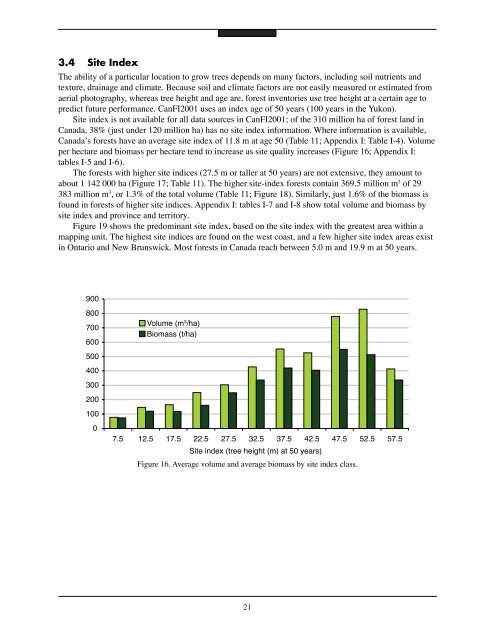Canada's Forest Inventory 2001 - Publications du gouvernement du ...
Canada's Forest Inventory 2001 - Publications du gouvernement du ...
Canada's Forest Inventory 2001 - Publications du gouvernement du ...
You also want an ePaper? Increase the reach of your titles
YUMPU automatically turns print PDFs into web optimized ePapers that Google loves.
3.4 Site Index<br />
The ability of a particular location to grow trees depends on many factors, including soil nutrients and<br />
texture, drainage and climate. Because soil and climate factors are not easily measured or estimated from<br />
aerial photography, whereas tree height and age are, forest inventories use tree height at a certain age to<br />
predict future performance. CanFI<strong>2001</strong> uses an index age of 50 years (100 years in the Yukon).<br />
Site index is not available for all data sources in CanFI<strong>2001</strong>; of the 310 million ha of forest land in<br />
Canada, 38% (just under 120 million ha) has no site index information. Where information is available,<br />
Canada’s forests have an average site index of 11.8 m at age 50 (Table 11; Appendix I: Table I-4). Volume<br />
per hectare and biomass per hectare tend to increase as site quality increases (Figure 16; Appendix I:<br />
tables I-5 and I-6).<br />
The forests with higher site indices (27.5 m or taller at 50 years) are not extensive, they amount to<br />
about 1 142 000 ha (Figure 17; Table 11). The higher site-index forests contain 369.5 million m 3 of 29<br />
383 million m 3 , or 1.3% of the total volume (Table 11; Figure 18). Similarly, just 1.6% of the biomass is<br />
found in forests of higher site indices. Appendix I: tables I-7 and I-8 show total volume and biomass by<br />
site index and province and territory.<br />
Figure 19 shows the predominant site index, based on the site index with the greatest area within a<br />
mapping unit. The highest site indices are found on the west coast, and a few higher site index areas exist<br />
in Ontario and New Brunswick. Most forests in Canada reach between 5.0 m and 19.9 m at 50 years.<br />
900<br />
800<br />
700<br />
600<br />
500<br />
400<br />
300<br />
200<br />
100<br />
0<br />
Volume (m 3 /ha)<br />
Biomass (t/ha)<br />
7.5 12.5 17.5 22.5 27.5 32.5 37.5 42.5 47.5 52.5 57.5<br />
Site index (tree height (m) at 50 years)<br />
Figure 16. Average volume and average biomass by site index class.<br />
21

















